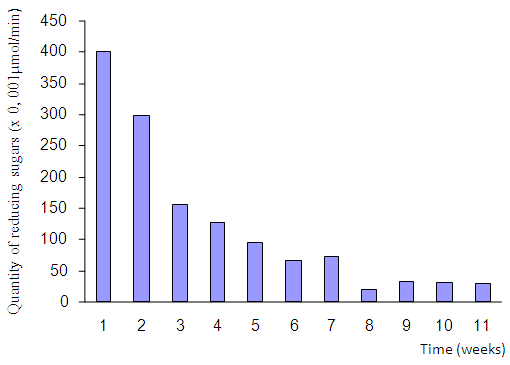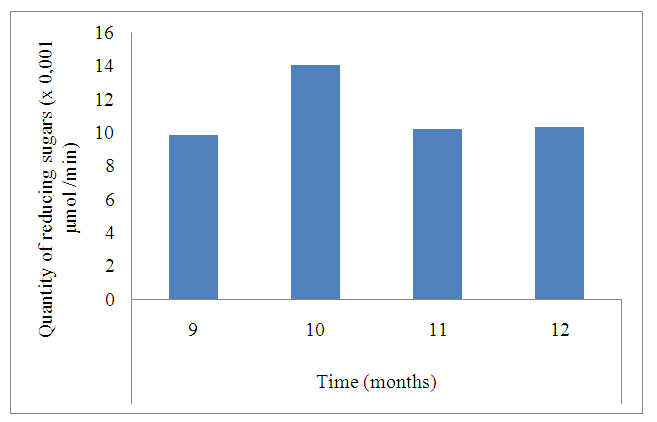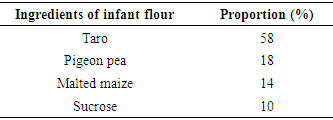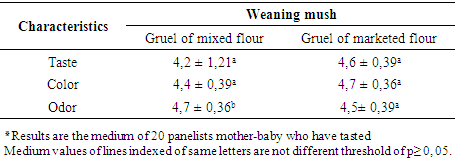-
Paper Information
- Paper Submission
-
Journal Information
- About This Journal
- Editorial Board
- Current Issue
- Archive
- Author Guidelines
- Contact Us
International Journal of Food Science and Nutrition Engineering
p-ISSN: 2166-5168 e-ISSN: 2166-5192
2021; 11(1): 27-33
doi:10.5923/j.food.20211101.03
Received: Mar. 14, 2021; Accepted: Apr. 16, 2021; Published: Apr. 30, 2021

Microbiological Quality and Amylase Activity of Weaning Flour Formulated from Taro (Colocasia Esculenta (L) Schott), Pigeon Pea (Cajanus Cajan) and Malted Maize (Zea Mays): Physicochemical and Organoleptic Characteristics of Weaning Mush
Dago A. Gnahé, Abba P. Obouayeba, Niaba PV Koffi, Massé Diomandé, Avit M. Beugré
Laboratoire d’Agrovalorisation, Departement de Biochimie-Microbiologie, Unité de Formation et de Recherche en Agroforesterie, Université Jean Lorougnon Guédé, Daloa, Côte d’Ivoire
Correspondence to: Abba P. Obouayeba, Laboratoire d’Agrovalorisation, Departement de Biochimie-Microbiologie, Unité de Formation et de Recherche en Agroforesterie, Université Jean Lorougnon Guédé, Daloa, Côte d’Ivoire.
| Email: |  |
Copyright © 2021 The Author(s). Published by Scientific & Academic Publishing.
This work is licensed under the Creative Commons Attribution International License (CC BY).
http://creativecommons.org/licenses/by/4.0/

Exclusive breastfeeding for 4-6 months of life, followed by appropriate complementary feeding, are major factors in the nutritional status of young children. The study aimed to produce infant flour from raw food ingredients available locally in Cote d’Ivoire. Infant flour has been proposed from mixed flours of Taro (Colocasia esculenta (L) Schott), legumes (Cajanus cajan), malted maize (Zea mays) and sucrose in a proportion of 58:18:14:10, respectively. In a first step of the study, the formulated infant flour was evaluated for a microbiological examination such as the total viable count, fecal coliforms, yeasts and molds counts, the detection of Escherichia coli and Salmonella and amylase activity was studied. Immediately after production, the total viable count (104 CFU / g) was below the maximum standard counts (105 CFU/g) and the flour was free from pathogens (Escherichia coli and Salmonella). The count of fecal coliforms (1 CFU/g) and yeasts and molds (1 CFU/g) were significantly lower than standard levels (102 and 103 CFU/g, respectively). As for the amylase activity, it was 0.400 μmol reducing sugars / minute the first week of preparation but after one year of storage, this activity was stabilized at 0.010 μmol reducing sugars/min. A second stage concerned the physico-chemical and organoleptic characteristics of the porridge made from formulated infant flour. The energy density of the porridge prepared from this infant flour was very high (approximately 119 kcal / 100 ml). A fluid consistency was 90 mm / 30 seconds.
Keywords: Porridge, Microbiological quality, Amylase activity, Physicochemical characteristics, Organoleptic
Cite this paper: Dago A. Gnahé, Abba P. Obouayeba, Niaba PV Koffi, Massé Diomandé, Avit M. Beugré, Microbiological Quality and Amylase Activity of Weaning Flour Formulated from Taro (Colocasia Esculenta (L) Schott), Pigeon Pea (Cajanus Cajan) and Malted Maize (Zea Mays): Physicochemical and Organoleptic Characteristics of Weaning Mush, International Journal of Food Science and Nutrition Engineering, Vol. 11 No. 1, 2021, pp. 27-33. doi: 10.5923/j.food.20211101.03.
1. Introduction
- In less developed countries, malnutrition is responsible for 60% of 10.9 million annual deaths of children under 5 years worldwide [1]. More than two thirds of deaths occurred in the early age and mostly resulted from inadequate feeding practices. Less than 35% of infant in the world are exclusively breastfed during the first six months of life [2]. At birth, mother’s milk is infant’s food par excellence at mammals which could cover the energy’s and nutriments needs of young children. But, from fourth to sixth months, the energy and micronutrients contents of milk could be not sufficient to satisfy the need of baby [3]. Normal growth and development of a child required meeting his nutritional needs through a balanced diet [4]. It is therefore necessary to supplement the infant's diet with certain foods to meet all of the infant's needs as they increase. The complementary foods must be then provided in balanced proportions, the major nutrients such as proteins, lipids and carbohydrates [5]. The foods initially received by infants, in addition to breast milk, are very often porridge prepared in fluid form. Thus, complementary flours, based on local products responding to consumption habits, have been developed in certain African countries by processing units [6-8]. The raw materials, generally used for these flours, are cereals (rice, millet, sorghum, corn), roots (cassava) or tubers (yam, taro) associated with legumes such as soybeans, beans or cowpeas [5].In Africa’s local language, weaning is merged in breast-feeding substitution by solid food. Therefore, from fourth to sixth months the infant is bound to family meals or to eating gruels made of cereal or tuber flours. In deed on the one hand, the composition in nutrients of baby’s food is poor and unbalanced; on the other hand, the richness in starch gave a high viscosity to the gruels [9]. So that, the gruels have been accepted for infantile consumption, the consistency of weaning mush must be fluid because of limited gastric capacity in infants. Therefore, the fermentation and germination of cereal grains have interest solutions used to reduce the high viscosity and increase the energy density of gruels [10]. The criteria of WHO recommended to have at least 30 dry matter of gruel, 100 to 120 kilocalories for 100 ml of mush of energy density and the content of protein equals 12-15 g for 100 g [11]. So, to protect the young children from infantile malnutrition, the baby’s food needed a mastery of physical, chemical, hygienic and organoleptic characteristics. The aim of this study was to formulate a complementary food from ingredients like taro, leguminous plant, malt maize, available in rural and urban areas of Côte d’Ivoire. Thus, present study has been designed for evaluating microbiological quality and amylase activity of weaning flour. The physicochemical and organoleptic characteristics of gruels prepared from weaning flour were determined and tested of acceptability among children aged 6 to 12 months of Abidjan district.
2. Materials and Methods
- This study was carried out in an urban area in the Abidjan district in the south of Cote d’Ivoire. Determination of acceptability test by mothers and their 6 to 12 months old children were the main steps of this study.Raw material plant Raw materials used in mixed flours production were constituted of low ground taro (Colocasia esculenta), seeds of pigeon pea (Cajanus cajan) and malted maize (Zea mays).Production of floursTaro flour Taro was peeled, washed, jagged, washing at 90°C during 5 min and then dried in an incubator at 65°C during 5 days. Then, the dried pieces of taro were crushed with a Forplex type grinder. Flour was obtained after sieving with sieve diameter from 180 to 500 μm.Malted maize flourSeeds are soaked during 48 hours then spread out on cloth humidified for 3 days. Malted maize is dried, sorted out, degermed and crushed. After sieving from 180 to 500 μm size sieves, malted maize flour was obtained.Pigeon pea flourSeeds are sorted, washed, roasted, and then crushed with Forplex type grinder. Flour was obtained after sieving with size sieve diameter from 180 to 500 μm.Production of infant flourThese ingredients were combined in precise doses: Taro (58%), Pigeon pea (18%), Malt maize (14%) and sucrose (10%). The flow chart of the flour formulation was simplified such that it is reproducible at household level. Preparation and characterization of weaning mushMush was prepared in aluminium saucepan and different proportions of Taro, Pigeon pea and malted maize flours and sucrose were mixed in water (180 ml) [13]. The flow distance (mm / 30 sec) of the gruels obtained was measured using a Bostwick consistometer [13]. Dry matter contents (DM) and consistency of mush were followed; the objective was to establish the best possible formulation.Biochemical analysesDetermination of the dry matter contentsDry matter contents (DM) of 1g of sample was measured after flours drying in an oven at 105°C for 24 hrs. Ash content (5 g) was determined by incineration of flour at 500°C in an oven [14]. Determination of the energy density in kilocalorieDry matter and energy of the porridge were determined using the formula suggest by Ouédraogo and collaborators [10].α-Amylase activityPreparation of rough enzymatic extract from mixed flours Flour (10 g) was mixed with 20 ml of a sodium chloride solution (NaCl 0,9%). The resulting mixture underwent to a sonication for 10 min and a centrifugation at 5 000 tours /min during 30 min. The supernatant, constituting the enzymatic crude extract was preserved for amylase activity study of prepared flour.In-vitro digestibility of flourThe starchy substrate used for this test was that of mixed flour. In-vitro flour digestibility consisted to a reaction between the enzymatic crude extract and an amount of flour at 1% (w/v). The reaction medium was constituted as follow: 500 μl of acetate buffer (100 mM, pH 5), 100 μl of enzymatic crude extract and 200 μl of 1% of flour. The mixture was then incubated at 37°C for 3 hours in a Marie-bath. Aliquots of the reaction medium were taken every 10 min for reducing sugars [14].Microbiological quality Preparation of test sample: Flour (10 g) was diluted in warm (45°C) sterile diluent peptone water solution (90 ml) to make primary dilution (10-1). Then a series up to 10-5 was prepared by transferring primary dilution (1 ml) into test tube containing sterile diluent (9 ml) to obtain 10-2 dilution and repeating the operations with sterile diluent (9 ml) using the 10-2 and further dilutions to obtain 10-3, 10-4and/or 10-5.Enumeration of total viable count (Colony count technique at 30°C): Total viable counts were enumerated [14]. Enumeration of yeasts and moulds counts (Colony count technique at 25°C): yeasts and moulds count were enumerated [14]. Enumeration of faecal coliforms counts (Colony count technique at 30°C): Add 50 g or 50 ml of test sample to 200 ml peptone water, then blend in a stomacher for 1 minute at medium speed. Make -1 to -3 dilutions in saline. Make duplicate plates on VRBL or EMB medium of each dilution by spread plate technique. Incubate for 18-24 hrs at 44°C, count red colonies with diameter greater than 0.5 m and calculate the number of fecal coliforms per gram or milliliter of sample. Subculture on EMB plates to confirm E. coli: Both positive and negative organisms control should be included with each batch of samples. Confirmation tests: Indol, ethyl red, Voges- Proskaure, Citrate, Catalase, oxidase, glucose and lactose fermentation.Detection of Salmonella: Add 25 g of test sample to 225 ml, of peptone water or selenite cystine broth, blend in stomacher for one minute at medium speed and, incubate for 16 hours at 37°C. Isolation of Salmonella: add 0.1 ml of culture to 10.0 ml of Rapport medium and incubate for 24 hours at 42°C. Add 2.0 ml of culture to 20.0 ml of selenite cystine medium and incubate for 24 hours at 37°C.Acceptability testThe acceptability test was a sensory evaluation of porridge prepared with the infant flour. Prior to this, a survey was performed in target households identified through the help of medical staff of health centers in the study area. The aim of the survey was to generate information about complementary feeding practices in the study area to help for estimating the amount of porridge to be to the children. Mothers were provided information on the test procedure and their assessment of the porridge was recorded. They were asked not to feed their children with any food including breast milk before coming for the test. Mothers and their children were separated from each other to avoid interference. The children were fed with a specific amount of gruel a standard bowl. Indeed, all children were fed in bowls of same size and color. Two repetitions inside an episode were offered to each child. When a child had consumed the whole amount of gruel offered during the first repetition, the same amount was immediately offered to him in order to continue the episode. On the other hand, when the child did not consume the first repetition, the remaining amount was offered to him at the first repetition of the following episode, after a five minute-break [15]. A child could then have one or two repetitions inside an episode and also had to make three episodes in order to confirm his attitude (denial or acceptance to continue the gruel consumption). During the acceptability test, each child was followed by an observer whose function was to give the gruel to the mother, to ensure that the child was not encouraged or forced to eat; and to fill out the questionnaire. The acceptability test always took place early in the morning between 7 and 8 am for three consecutive days. Number of episodes, gruel’s quantity consumed by episode and period of consumption were recorded. Other variables such as total quantity of gruel consumed and speed of the gruel ingestion were also calculated [15]. Mother’s assessment of gruel was a relevant indicator for further steps in the programme implementation. Mothers were asked to assess the taste, consistency and color of the gruel using a five level Liker scale ranging from unpleasant to very pleasant.Sampling for acceptability tests A group of 123 children aged 6 to 12 months were identified from a list provided by health centers. Children’s age was reported from heath books or birth certificates in the village health centre. Where these documents were unavailable, social or national events was used for age estimation. A questionnaire was administrated to mothers on infant feeding habits.Several criteria were used for sampling: age (6-12 months), feeding mode (spoon or cup), usual time of first meal (7-8 am) and parents ‘agreement. After analyzing the data collected based on the questionnaire, sixty-five mothers and their children (of which there was a twin) who fulfilled the selection criteria and accepted to participate to the study were enrolled [15].Data analysis Nutritional and microbiological characteristics of the infant flour were compared to Codex Alimentarius standards through a conformity test of means. After ensuring that required conditions were met, analysis of variance was used to examine difference in gruel intake between three consecutive days of test and within child day-to-day variations. Proportion of gruel consumed by the child during the test, duration of the test and average speed of gruel consumption were calculated for each child. Statistical Package for Social Sciences software (SPSS 16.0, SPSS Inc., USA) was used for statistical analyses. The statistical significance for all analyses was set at 5% and all tests were two-sided. Data collected during mother’s acceptability test was analyzed in a descriptive way. Representatives of the Ministry of the Health in the Abidjan district gave their verbal approval for the implementation of the study. Administrative local authorities such as Prefect and Mayor were informed about the study and gave their verbal consent. Selected mothers were informed about their duties and right in participation in the study.
3. Results
- Weaning flour formulated The combination of ingredients used in weaning flour formulated was 58% of taro, 18% of pigeon pea, 14% of malted maize and 10% sucrose, the best combination among all those were tried out (Table 1).
|
|
 | Figure 1. α-amylase activity of infant flour during a conservation time |
 | Figure 2. α-amylase activity of infant flour during one year of conservation |
|
|
|
4. Discussion
- The development of a healthy and quality complementary food that met international criteria required technical skills and expertise to take into account several technological, microbiological and nutritional parameters. This required applying the appropriate formulation methods [16]. Infant flour should be contained the macronutrients and micronutrients in quantity and quality necessary for the harmonious growth of the child [16]. In the present study, the principle of mixing various ingredients is useful to meet this requirement. The development of a nutrient-balanced flour meeting WHO standards [17] guided in this study. Indeed, each ingredient provided in the formula must be contributed to solving a nutritional requirement. Thus, in the formulation, the taro flour was a source of energy and the basis of weaning flour while the pigeon pea provided the proteins and the malted corn the enzymes.Raw food ingredients used for the formulation of the infant flour (taro, pigeon pea, malted maize and sucrose) and their respective proportion (58%, 18%, 14% and 10%) were similar to the ones used for Bitamin flour (millet: 67%, Bean: 20% and pulp baobab’s fruit: 3%) promoted in Republic of Niger [18]. Millet and baobab pulp were used as cereal and minerals and vitamins sources respectively whereas in the Benin infant flour, maize and water from boiled leafy vegetable were used [19].Mush had a high energy density (119 kcal/100 ml of mush) true to international criteria of WHO/UNICEF (1998) [20]. This energy could be sufficient to satisfy the energy needs of young children. Moreover, the supply of malted maize has improved the consistency of mush flour infant. The children would eat easily that gruel.When porridge is viscous and heavy, it is indigestible, and children after consuming a small amount feel full. These types of traditional porridge are therefore unsuitable for children as they cannot meet their nutritional needs. The incorporation of low doses of sprouted corn flour (source of alpha amylases) in heavy and viscous porridge results in an increase in flow rate associated with an increase in dry matter and energy density [21]. Prepared porridge is liquid and fluid. This is due to the hydrolytic action of alpha amylases which break down large starch molecules into smaller molecules (maltodextrins) with reduced swelling capacity. Sprouted corn flour therefore predigests starch in order to make porridge more digestible and easier to consume. The present results corroborate those obtained with Zannou-Tchoko et al. [22] who used small amounts of germinated millet flour (5 to 15%) to reduce the viscosity of weaning porridges made from cassava and its derivative, attiéké. The low dose of 14% of sprouted corn flour, flows of 90 mm/30 s, a dry matter of 30%, an energy density of 119 Kcal / 100 ml of porridge and a protein content of 15.75 g/100 g corresponding to FAO/WHO standards [23] according to the work of Kouassi et al. [24]. These values highlight the quality and ability of sprouted corn flour to predigest starch. The results of the present study are in agreement with those of several authors having similar values for the same parameters with different cases [16,22,24].The aerobic mesophilic flora that was found complies with the criteria defined by the FAO/WHO since no result exceeded the limit of 105 CFU/g. Also, total coliforms count ranged from 1 to 10 CFU of fecal coliforms in 1 g of the sample; however, Escherichia coli has not been identified. In the samples analyzed (respectively just after the production of the flour and one year after the production of this flour), yeasts and molds in the flour did not exceed the recommendation which is 103 CFU/g. Salmonella is absent in our sample. In summary, in the presence of micro-organisms indicative of general hygiene and in the absence of identified potentially pathogenic germs, it can be concluded that the consumption of this infant flour does not present a danger to health. These results are consistent with some studies [25-29].
5. Conclusions
- Weaning mush prepared from mixed flours showed that this infantile flour could cover the energy’s needs and nutriments needs of young children. Therefore, the mush weaning had a good consistency, a good content of dry matter and high energy density sufficient for children.
 Abstract
Abstract Reference
Reference Full-Text PDF
Full-Text PDF Full-text HTML
Full-text HTML



